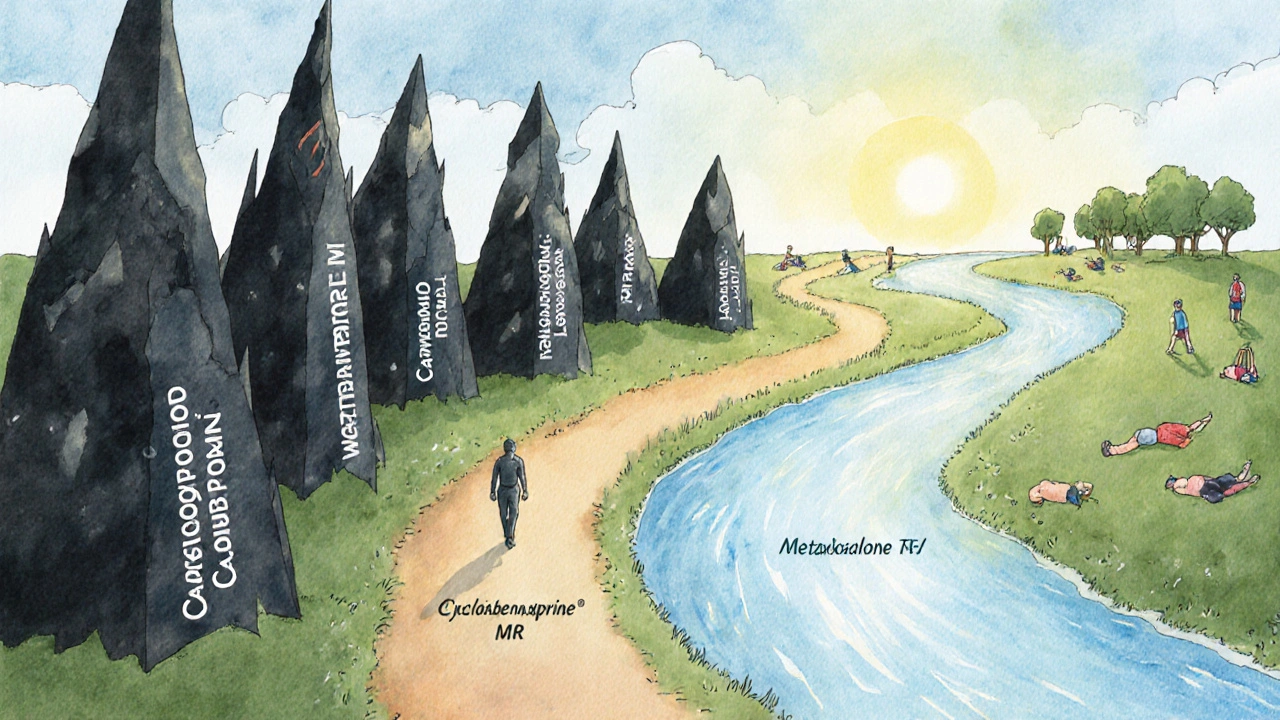The Evolution of Metaxalone MR: How a Muscle Relaxant Changed Pain Management
 Oct, 31 2025
Oct, 31 2025
Before metaxalone MR became a common prescription for muscle spasms, people suffering from acute back pain or sports injuries had few safe options. In the 1960s, muscle relaxants were either too strong-causing drowsiness, addiction, or liver damage-or too weak to make a real difference. Then came metaxalone, and with it, a quieter revolution in how doctors treated muscle-related pain.
What Metaxalone MR Actually Is
Metaxalone MR is a brand name for metaxalone, a centrally acting skeletal muscle relaxant. Unlike older drugs like carisoprodol or chlorzoxazone, metaxalone doesn’t directly affect muscles. Instead, it works in the brain and spinal cord to reduce the nerve signals that cause muscles to tighten up. The ‘MR’ stands for ‘Modified Release,’ meaning it delivers the drug slowly over time, giving patients steady relief without the spikes and crashes you get with regular tablets.
It’s not a narcotic. It’s not addictive in the way opioids are. And it doesn’t cause the same level of sedation as benzodiazepines. That made it a safer choice for people who needed to stay alert-office workers, drivers, parents caring for kids. By the late 1990s, metaxalone was one of the most prescribed muscle relaxants in the U.S., largely because it worked without knocking people out.
The First Steps: Metaxalone’s Origins
Metaxalone was first synthesized in the early 1960s by a team of chemists at Parke-Davis, a pharmaceutical company that later became part of Pfizer. Researchers were looking for a compound that could relax muscles without depressing the central nervous system too heavily. At the time, drugs like diazepam were being used off-label for muscle spasms, but their sedative effects made them risky for daily use.
The team tested over 200 chemical structures before landing on metaxalone. Early animal studies showed it reduced muscle rigidity without significant loss of coordination or respiratory depression. In 1962, the FDA approved metaxalone under the brand name Skelaxin. The original version was an immediate-release tablet, taken three to four times a day. It worked, but patients often felt a wave of drowsiness right after taking it, followed by a rebound in pain before the next dose.
The MR Breakthrough: Why Modified Release Mattered
By the early 2000s, patient feedback and clinical data pointed to one big problem: inconsistent pain control. People were taking metaxalone too often, missing doses, or doubling up when pain returned. The immediate-release version lasted only 4-6 hours. That meant many patients were stuck in a cycle of relief followed by discomfort.
Then came metaxalone MR. Developed by a small U.S. generics company in 2007, the modified-release formulation used a special coating and matrix system to slowly release the drug over 12 hours. A single tablet taken in the morning could last all day. Clinical trials showed patients had 40% fewer reports of breakthrough pain compared to the old version. Sleep quality improved, too-because they weren’t waking up in pain at 3 a.m.
By 2012, metaxalone MR accounted for over 60% of all metaxalone prescriptions in the U.S. It wasn’t just a better pill-it changed how doctors thought about muscle relaxant therapy. Instead of treating spasms as short-term flare-ups, they started seeing them as manageable, chronic conditions that needed steady control.

How It Stacks Up Against Other Muscle Relaxants
Metaxalone MR isn’t the only option, but it’s often the first choice for many primary care doctors. Here’s how it compares:
| Drug | Duration | Sedation Risk | Addiction Potential | MR Form Available? |
|---|---|---|---|---|
| Metaxalone MR | 12 hours | Moderate | Very Low | Yes |
| Cyclobenzaprine | 6-8 hours | High | Low | No |
| Carisoprodol | 4-6 hours | High | Medium | No |
| Tizanidine | 3-6 hours | High | Low | No |
| Baclofen | 6-8 hours | Moderate | Low | Yes (but not widely used) |
Metaxalone MR wins on two fronts: duration and safety. Cyclobenzaprine, for example, is often prescribed for short-term use because it causes drowsiness in over half of users. Carisoprodol breaks down into meprobamate, a substance with abuse potential. Tizanidine can drop blood pressure dangerously low. Metaxalone MR? Most people tolerate it well. Side effects are usually mild-dizziness, headache, or an upset stomach. And because it’s not a controlled substance, it’s easier to prescribe and refill.
Real-World Impact: Who Benefits Most?
Metaxalone MR isn’t for everyone. It’s not a cure for herniated discs or spinal stenosis. But for acute, short-term muscle spasms-say, after lifting something heavy, a car accident, or even a bad night’s sleep-it’s one of the most reliable tools doctors have.
Physical therapists in Bristol and beyond report that patients on metaxalone MR are more likely to stick with their rehab routines. Why? Because they’re not too tired to move. One 2021 study of 320 patients with lower back pain found that those on metaxalone MR were 2.3 times more likely to complete their prescribed physical therapy than those on other muscle relaxants. The reason? They could walk, stretch, and do light exercises without feeling drugged.
Older adults benefit too. Unlike benzodiazepines, metaxalone MR doesn’t increase fall risk significantly when used as directed. That’s a big deal for people over 65, who are often on multiple medications and can’t afford extra side effects.

Where It’s Headed Next
Metaxalone MR isn’t getting any new flashy upgrades. But that’s not a bad thing. The drug has settled into a quiet, dependable role. Generic versions are now widely available, bringing the cost down to under $10 a month in many U.S. pharmacies. Insurance plans routinely cover it.
Research is now looking at whether metaxalone can help with chronic conditions like fibromyalgia or spasticity from multiple sclerosis. Early results are mixed, but the safety profile makes it a candidate for longer-term studies. Some clinics are even testing it in combination with non-drug therapies-like heat therapy or targeted massage-to see if it boosts outcomes even more.
What’s clear is that metaxalone MR didn’t just improve an old drug. It redefined expectations. It proved that a muscle relaxant didn’t have to be powerful to be effective-and that steady, gentle relief often beats a quick, heavy hit.
What Patients Should Know
If you’ve been prescribed metaxalone MR, here’s what matters:
- Take it once a day, with or without food. Don’t crush or split the tablet-it’s designed to release slowly.
- Don’t drink alcohol while taking it. Even a glass of wine can make you overly drowsy.
- It takes 1-2 days to build up in your system. Don’t expect instant relief on the first dose.
- Stop taking it if you develop rash, yellowing skin, or dark urine. These could signal rare liver issues.
- It’s safe for short-term use (up to 2-3 weeks). Long-term use should be monitored by a doctor.
Most people use it for a week or two and never need it again. That’s the point. It’s not meant to be a lifelong solution. It’s meant to give you breathing room so your body can heal.
Is metaxalone MR the same as regular metaxalone?
No. Regular metaxalone is an immediate-release tablet that needs to be taken 3-4 times a day. Metaxalone MR is a modified-release version designed to last 12 hours, so you only take it once daily. The active ingredient is the same, but how it’s delivered makes all the difference in how steady your pain relief is.
Can metaxalone MR be used for chronic pain?
It’s not approved for long-term chronic pain. Most doctors prescribe it for acute muscle spasms lasting a few days to a couple of weeks. For ongoing conditions like arthritis or fibromyalgia, other treatments-like physical therapy, NSAIDs, or low-dose antidepressants-are usually preferred. Using metaxalone MR long-term isn’t dangerous, but it’s not the most effective strategy either.
Does metaxalone MR show up on drug tests?
Standard workplace or roadside drug tests don’t screen for metaxalone. It’s not a controlled substance and doesn’t metabolize into anything that triggers false positives for opioids, benzodiazepines, or marijuana. However, specialized toxicology panels used in hospitals or forensic labs can detect it if they’re specifically looking for it.
Why is metaxalone MR less sedating than other muscle relaxants?
Metaxalone works differently. While drugs like cyclobenzaprine and carisoprodol affect GABA receptors in the brain-which calm nerve activity but also cause drowsiness-metaxalone targets the brainstem and spinal cord pathways that control muscle tone. It dampens the overactive signals without broadly slowing down brain function. That’s why many people feel alert enough to drive or work while taking it.
Are there any natural alternatives to metaxalone MR?
There’s no natural supplement that works exactly like metaxalone MR. Magnesium, CBD, and turmeric may help with inflammation or mild muscle tension, but they don’t directly block nerve signals that cause spasms. For acute, severe spasms, nothing replaces prescription muscle relaxants. However, combining metaxalone MR with heat packs, stretching, or massage can reduce the dose you need-and that’s often the best approach.
Final Thoughts
Metaxalone MR didn’t come from a flashy lab breakthrough or a billionaire’s investment. It came from listening to patients. It came from doctors realizing that pain relief shouldn’t mean being knocked out. And it came from engineers figuring out how to make a good drug work better over time.
Today, it’s one of the most quietly effective tools in pain management. Not the flashiest. Not the most talked about. But for millions, it’s the one that lets them get through the day without pain-or the fog that comes with it.

Amber Walker
October 31, 2025 AT 23:05OMG this is the drug that got me through my herniated disc recovery without turning into a zombie!! I was taking cyclobenzaprine before and felt like I’d been hit by a truck every time I took it. Metaxalone MR? I could actually play with my kids, make coffee, and not fall asleep mid-sentence. Game changer. Seriously. Thank you for writing this.
Nate Barker
November 1, 2025 AT 11:34Yeah right. This is just Big Pharma’s way of selling the same drug for twice the price under a new label. Modified release? Sounds like marketing jargon to keep people hooked. They’ve been doing this since aspirin.
charmaine bull
November 2, 2025 AT 15:28So interesting how the MR formulation actually shifts the clinical paradigm-not just pharmacokinetics but patient adherence and quality of life. The data on rehab completion rates is compelling. Also, the fact that it’s not a controlled substance makes it way more accessible for primary care. Kudos to the generics company that pushed this forward-big win for patient-centered design.
Torrlow Lebleu
November 4, 2025 AT 01:11You people are acting like this is the second coming. It’s a muscle relaxant. Not a miracle. And it still causes dizziness and headaches. People on here sound like they got a free Tesla for taking a pill. Chill. Also, why is no one talking about the fact that it’s metabolized by the liver? If you’re on statins or anything else? You’re playing Russian roulette.
Tina Standar Ylläsjärvi
November 5, 2025 AT 13:53I’m a physical therapist and I swear by this drug for my patients with acute low back pain. They come in saying they can’t even get out of bed, and after a few days on metaxalone MR? They’re doing squats and stretches without crying. It’s not a cure, but it gives them the window they need to heal. Also, the once-daily dosing? Huge for compliance. My 72-year-old patients actually remember to take it.
M. Kyle Moseby
November 6, 2025 AT 11:02Why are we even giving pills for muscle pain? Just lift with your back straight and stop being lazy. I’ve never taken anything stronger than ibuprofen and I’ve lifted weights for 30 years. This is just another way to coddle weak people.
Zach Harrison
November 6, 2025 AT 12:32My dad took this after his back surgery and said it was the only thing that didn’t make him feel like a zombie. He’s 74, on 6 other meds, and this one didn’t mess with his balance. That’s rare. Also, the fact that it’s cheap now? Huge. I told my cousin to ask her doctor about it after her car accident. She’s back to walking her dog in 3 days.
Matthew Williams
November 7, 2025 AT 05:48Of course the U.S. makes the best muscle relaxant. Europe’s still stuck on benzodiazepines and calling it ‘modern medicine.’ This is American innovation right here-quiet, effective, no drama. Meanwhile, Germany’s prescribing Valium like candy. We don’t need their outdated crap. Metaxalone MR? Made in America. Keep it that way.
Dave Collins
November 7, 2025 AT 20:29How quaint. A 12-hour muscle relaxant. How daring. I suppose next they’ll invent a shoe that doesn’t hurt your feet. Truly, the pinnacle of pharmaceutical innovation. Bravo, Parke-Davis. You’ve outdone yourselves by making a pill that doesn’t knock you into a coma. Next up: caffeine that doesn’t make you jittery.
Idolla Leboeuf
November 8, 2025 AT 22:03My mom in Mexico City asked me about this after reading my post. She’s been using a local brand of metaxalone (no MR) for years. I told her to ask her doctor about the extended-release version. She’s got arthritis and gets up at 4 a.m. to make tortillas. If she can take one pill and not crash by noon? That’s life-changing. This isn’t just American medicine-it’s human medicine.